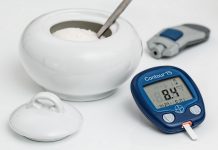
When you measure a cooked vegetable, more cooked vegetable (weight) fits in a 1/2 cup compared to the raw version. Serving size and whether a vegetable is counted as free, vegetable or starch exchange is dependent on the number of grams of carbohydrate per serving (around 1/2 cup for vegetables).
Non-starchy vegetables like 1/4 cup carrots, cauliflower, celery and green beans cooked or 1/2 cup raw cabbage or cucumber and any amount of greens are considered free foods because they contain less than 5 grams carbohydrate with less than 20 calories.
Some other examples of free foods are 1 tablespoon of fat-free versions of cream cheese, liquid creamer, margarine spread, mayonnaise or mayonnaise-style salad dressing, salad dressing, sour cream or regular whipped cream. Condiments such as 1 tablespoon of catsup, honey mustard, Parmesan cheese, pickle relish, soy sauce or taco sauce. As long as you eat less than 2 teaspoons, barbeque sauce, sweet and sour sauce and chili sauce are free whereas you can eat up to 1/4 cup of salsa.
Free foods do not count in carbohydrate calculations when they are eaten in moderation (less than 3 servings per day and not more than 1 per meal). The key word is moderation. These foods are not calorie free. For example, if one consumes 3 tablespoons of fat- free mayonnaise or salad dressing at one meal, it counts as a fat exchange.
The exchange lists provide a quick way to estimate calories, carbohydrate, protein and fat content in any food or meal. Serving sizes in each exchange (starch, fruit, milk, vegetable, meat or meat substitute, and fat) are defined so that one serving of each food contains about the same amount of carbohydrate, protein, fat, and calories.



